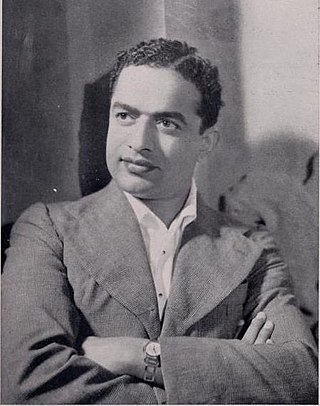
Shantaram Rajaram Vankudre, also known as V. Shantaram or Shantaram Bapu, was an Indian film director, producer, screenwriter, and actor known for his work in Hindi and Marathi films. He is best known for films such as Dr. Kotnis Ki Amar Kahani (1946), Amar Bhoopali (1951), Jhanak Jhanak Payal Baaje (1955), Do Aankhen Barah Haath (1957), Navrang (1959), Duniya Na Mane (1937), Pinjara (1972), Chani, Iye Marathiche Nagari and Zunj.

Marathi Cinema, also known as Marathi film industry, is the segment of Indian cinema dedicated to the production of motion pictures in the Marathi language widely spoken in the state of Maharashtra. It is based in Mumbai. It is the oldest film industry of India and one of the leaders in filmmaking in the Indian film industry.
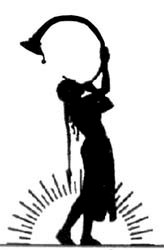
Prabhat Film Company was an Indian film production company and studio facility founded in 1929 in Kolhapur. It was established by filmmaker V. Shantaram, along with Vishnupant Govind Damle, Keshav Rao Dhaibar, S. Fatelal, and S. V. Kulkarni. The company gained prominence during the transition from silent films to talkies and was recognised for its technical excellence and socially conscious storytelling.

Keshavrao Date (1889–1971) was an Indian film actor, who worked in both silent and sound movies. He tried to run his own drama company but found it difficult to perform the dual roles of manager and actor.
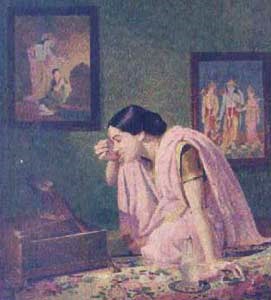
Kunku is a 1937 Indian Marathi-language classic social drama film directed by V. Shantaram, and based on the novel, Na Patnari Goshta by Narayan Hari Apte, who also wrote film's screenplay. The film was simultaneously shot and released in Hindi as Duniya Na Maane.
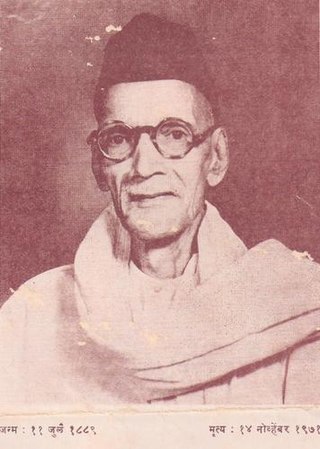
Narayan Hari Apte, popularly known as Nanasaheb Apte was a Marathi popular novelist, writer of advice books and editor from Maharashtra, India.

Ayodhyecha Raja, literally "The King of Ayodhya", was the first Marathi talkie, released in 1932, directed by Shantaram Rajaram Vankudre. It is based on the puranic story of Raja Harishchandra of Ayodhya and his test by sage Vishwamitra, as recounted in Valmiki's epic, Ramayana.
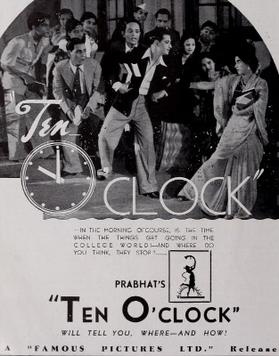
Das Baje, also called 10 O'Clock, is an Indian film. It was released in 1942. This was a debut direction for Raja Nene, a protege of V. Shantaram, and produced under Shantaram's Prabhat Film Company banner. The film was a bilingual, made in Hindi, and in the Marathi language as Daha Wajta. The music direction was by Keshavrao Bhole. The story was written by Kashyap and Pawar, with dialogues in Hindi by Ashant. The photography was by E. Mohammed. It starred Paresh Bannerji, Urmila and Vasant Thengdi in the lead roles, with Baby Shakuntala and Manajirao forming the supporting cast.

Keshav Vaman Bhole, also known as Keshavrao Bhole, was a well-known music composer and critic in Indian cinema.
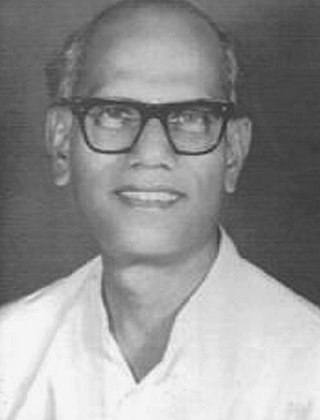
Shantaram Govind Athavale was an Indian director of Marathi, Hindi and English language films, a lyricist, poet, and author. Part of the generation that emerged from the Prabhat Film Company in Pune in the 1930s, he made pioneering contributions to Marathi film.

Amrit Manthan is a 1934 Indian costume-drama film directed by V. Shantaram for his Prabhat Film Company. The film was produced simultaneously in Hindi and Marathi. The film starred Chandra Mohan, Nalini Tarkhad, Shanta Apte, G. R. Mane, Varde and Kelkar. The film was based on Narayan Hari Apte's novel Bhagyashree. The Hindi translation was done by Veer Mohammed Puri, who also wrote the lyrics for the film.
Rajkamal Kalamandir was a noted film production company and studio in Mumbai. It was established by V. Shantaram in 1942, after he left Prabhat Films. The studio produced films both in Hindi and Marathi, and it was best known for Dr. Kotnis Ki Amar Kahani (1946), Amar Bhoopali (1951), Jhanak Jhanak Payal Baaje (1955), Do Aankhen Barah Haath (1957), Navrang (1959) and Pinjra (1972). In its heyday, Rajkamal was one of the most sophisticated studios of the country.
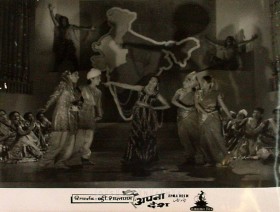
Apna Desh is a 1949 Hindi social drama film set against the backdrop of Partition and directed by V. Shantaram for his Rajkamal Kalamandir banner.

Udaykal is a 1930 historical silent film co-directed by V. Shantaram and Keshavrao Dhaiber. It was produced by Prabhat Film Company. The story was written by Baburao Pendharkar. The cinematographers were S. Fattelal and V. G. Damle. The film starred V. Shantaram, Baburao Pendharkar, Kamla Devi, G. R. Mane, Ibrahim and Dhaiber.

Sinhagad is a 1933 Marathi historical fact film directed by V. Shantaram. The production company was Prabhat Film Company. The story was based on Hari Narayan Apte's literary classic novel "Gad Ala Pan Sinha Gela". Apte was a famous Marathi novelist of the early twentieth century. The story's screenplay and dialogue were written by Narayan Hari Apte. The cinematographers were V. Avadhoot and Keshavrao Dhaiber. The cast included Master Vinayak, Baburao Pendharkar, Keshavrao Dhaiber, Leela Chandragiri, Shinde, Prabhavati, Budasaheb and Shankarrao Bhosle.
Rani Saheba also called Bazarbattu is a 1930 Indian silent film. It is cited as the first children's film made in India. The film was co-directed by V. Shantaram and Keshavrao Dhaiber. The cinematographers were S. Fattelal and Vishnupant Govind Damle and the cast included Keshavrao Dhaiber, Baburao Pendharkar, V. Shantaram and Anant Apte.

Manoos, also called Life's for Living, is a 1939 Indian Marathi social melodrama film directed by V. Shantaram. The movie was simultaneously made in Hindi as Aadmi. The film was based on a short story called "The Police Constable". The story was by A. Bhaskarrao, with screenplay and dialogue by Anant Kanekar. The cinematographer was V. Avadhoot and the music was composed by Master Krishna Rao, with lyrics by Kanekar. The cast included Shahu Modak, Shanta Hublikar, Sundara Bai, Ram Marathe, Narmada, Ganpatrao and Raja Paranjpe.
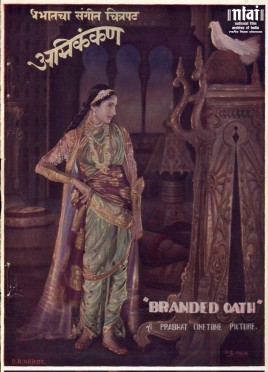
Agnikankan: Branded Oath also called The Branded Oath, is a 1932 Marathi adventure film directed by V. Shantaram. The film was a Prabhat Film Company production and was a bilingual, called Jalti Nishani in Hindi. The cinematography was done by Keshavrao Dhaiber and Art direction by S. Fatehlal. The sound direction was by Vishnupant Govind Damle and the music and lyrics were by Govindrao Tembe. Dialogues for the movie are written by Govindrao Tembe. The character artist Gajanan Jagirdar began his career in films by acting the role of a seventy-five-year-old man at the age of twenty-five. The cast included Shankarrao Bhosle, Kamala Devi, Master Vinayak, Baburao Pendharkar, Nimbalkar and Jagirdar.
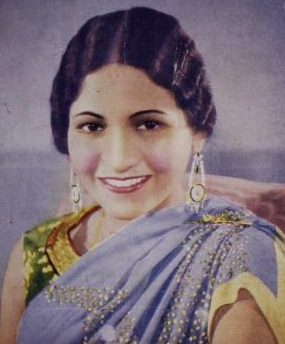
Hansa Wadkar (1923–1971) was a Marathi and Hindi film and stage actress of Indian cinema. She started her acting career at the age of thirteen years, as a heroine in the bilingual film Vijaychi Lagne (1936). Wadkar went on to make a name for herself working in the reputable film companies like Bombay Talkies, Prabhat Film Company and National Studios. Her career defining role was in Vishnupant Damle's Sant Sakhu (1941) where she enacted the role of the female saint Sakhu. Her other memorable roles were in the Tamasha genre films like Lokshahir Ram Joshi (1947), termed as the "Classic Marathi Tamasha musical". Sangtye Aika (1959) was another of Marathi cinema's "best known Tamasha film" along with Ram Joshi. She thus acted in two of Marathi cinema's biggest hits Lokshahir Ramjoshi and Sangtye Aika. The title "Sangtye Aika" was used by Wadkar for her autobiography compiled in 1971. The autobiography was initially serialised in the Marathi magazine Manoos helped by journalist Arun Sadhu.



















